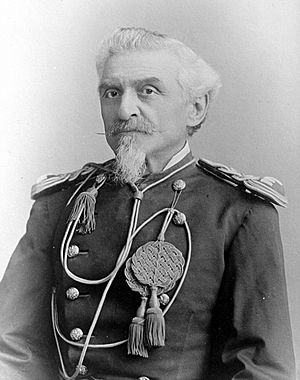Charles DeRudio facts for kids
Quick facts for kids
Charles Camillo DeRudio
|
|
|---|---|

Charles C. DeRudio
|
|
| Birth name | Carlo Camillo Di Rudio |
| Born | August 26, 1832 Belluno, Kingdom of Lombardy–Venetia |
| Died | November 1, 1910 (aged 78) Pasadena, California |
| Place of interment | |
| Allegiance | Italian Revolution United States of America |
| Service/ |
United States Army |
| Years of service | 1864–1866 1867–1896 |
| Rank | Major |
| Unit | 7th U.S. Cavalry Regiment |
| Battles/wars | First Italian War of Independence American Civil War Indian Wars |
Charles Camillo DeRudio (born Carlo Camillo Di Rudio; August 26, 1832 – November 1, 1910) was an Italian nobleman with an adventurous life. He was involved in a plot against Emperor Napoleon III of France. Later, he became a dedicated officer in the U.S. Army. He is well-known for fighting with the 7th U.S. Cavalry Regiment at the famous Battle of the Little Bighorn.
Contents
Early Life and Adventures
Carlo di Rudio was born in Belluno, Italy. He came from a noble family. As a teenager, he went to a military school in Milan. When he was just 15, he left school to join Italian freedom fighters. This was during an uprising in 1848. He helped defend Rome and Venice against Austrian forces.
After these events, he tried to sail to America but his ship was wrecked near Spain. By 1855, he was living in London, England. There, he married Eliza and they had five children together.
A Plot in Paris
On January 14, 1858, Charles DeRudio was involved in a serious event in Paris, France. Three bombs were thrown at Emperor Napoleon III's carriage. This happened outside the Paris Opera. Eight people were killed and many more were hurt.
DeRudio and three other men were arrested. The leader of the plot, Felice Orsini, and another man were executed. DeRudio was first sentenced to death too. However, his sentence was changed to life in prison on Devil's Island. This was a harsh prison in French Guiana.
Amazingly, DeRudio managed to escape from Devil's Island a few months later. He and twelve others made their way to British Guiana. From there, he returned to London to be with his family. His name was changed to 'Charles DeRudio' to sound more English.
Serving in the American Civil War
In 1860, DeRudio moved to New York City in the United States. He joined the 79th New York Infantry Regiment as a private. He fought for about two months during the Siege of Petersburg in Virginia.
In November 1864, he became a second lieutenant in the 2nd U.S. Colored Infantry Regiment. He served with this unit in Florida until January 1866.
Joining the Regular Army
After the Civil War, DeRudio wanted to join the regular U.S. Army. He became a second lieutenant in the 2nd Infantry Regiment in August 1867. There was a brief issue with his health and his past "political activity." But he soon returned to duty.
With the 7th Cavalry
In July 1869, DeRudio joined the famous 7th Cavalry Regiment. He was 37 years old at the time. He was first assigned to Company H. The commander, Captain Frederick Benteen, gave him the nickname "Count No Account." This was because DeRudio sometimes boasted and acted a bit proud.
Even so, DeRudio was a good officer. He was reliable and knew how to lead his men. In December 1875, he was promoted to first lieutenant. He was then assigned to Company E.
Before the Battle of the Little Bighorn, there were some changes in command. Lieutenant Colonel George A. Custer moved DeRudio to Company A. This change actually saved DeRudio's life.
The Battle of the Little Bighorn
On June 25, 1876, DeRudio was with Company A as part of Major Marcus Reno's group. They crossed the Little Bighorn River to attack a Native American village. DeRudio's company fought on foot against Hunkpapa and Oglala warriors.
As more warriors arrived, Major Reno ordered a retreat back across the river. During this retreat, DeRudio lost his horse and was left behind. He and another soldier, Private Thomas O'Neill, hid in the woods for 36 hours. They had some close calls with the warriors. But they managed to stay hidden. Early on June 27, they finally crossed the river. They rejoined the rest of the troops on Reno Hill.
DeRudio's exciting story was published in newspapers. He later said he didn't write the story himself. He claimed someone else wrote it based on his information.
Years later, DeRudio said he was the only soldier at the Little Bighorn who still had his saber. He had received a golden saber as a gift in 1870. Custer had told him off for accepting it. Perhaps out of defiance, DeRudio kept his saber when others were stored away.
Later Military Service
After the Battle of the Little Bighorn, DeRudio continued his service. He commanded Company E during the Nez Perce War in 1877. He also testified in the Reno Court of Inquiry in 1879. This inquiry looked into Major Reno's actions at Little Bighorn.
DeRudio was promoted to captain in December 1882. He served at different forts, including Fort Meade, Fort Sam Houston, and Fort Bayard.
He retired from the army on August 26, 1896, at the age of 64. In 1904, he was promoted to the rank of major on the retired list. This was to honor his service during the Civil War.
Charles DeRudio passed away in 1910 in Pasadena, California. He was buried in the San Francisco National Cemetery.
Images for kids


